INFO6001: Database Management 1 - Popular Pizza Project Assignment
VerifiedAdded on 2022/08/09
|11
|1491
|453
Project
AI Summary
This assignment presents a database design project for "Popular Pizza," a pizza outlet aiming to computerize its records. The project begins with an analysis of user requirements, including data, transaction, and business rules. The data requirements detail the information to be stored, such as customer contacts, order details, employee information, and item/ingredient specifics. Transaction requirements define the processes within the database, including order processing, payment methods, and employee shift records. Business rules outline operational procedures like order taking, delivery services, and stock management. The second part of the assignment focuses on the conceptual design, featuring an Entity-Relationship (EER) model to visually represent the database structure and a data dictionary providing detailed descriptions of each attribute, including data types and field sizes for entities such as orders, items, employees, and ingredients. Finally, a bibliography of relevant database management sources is included.
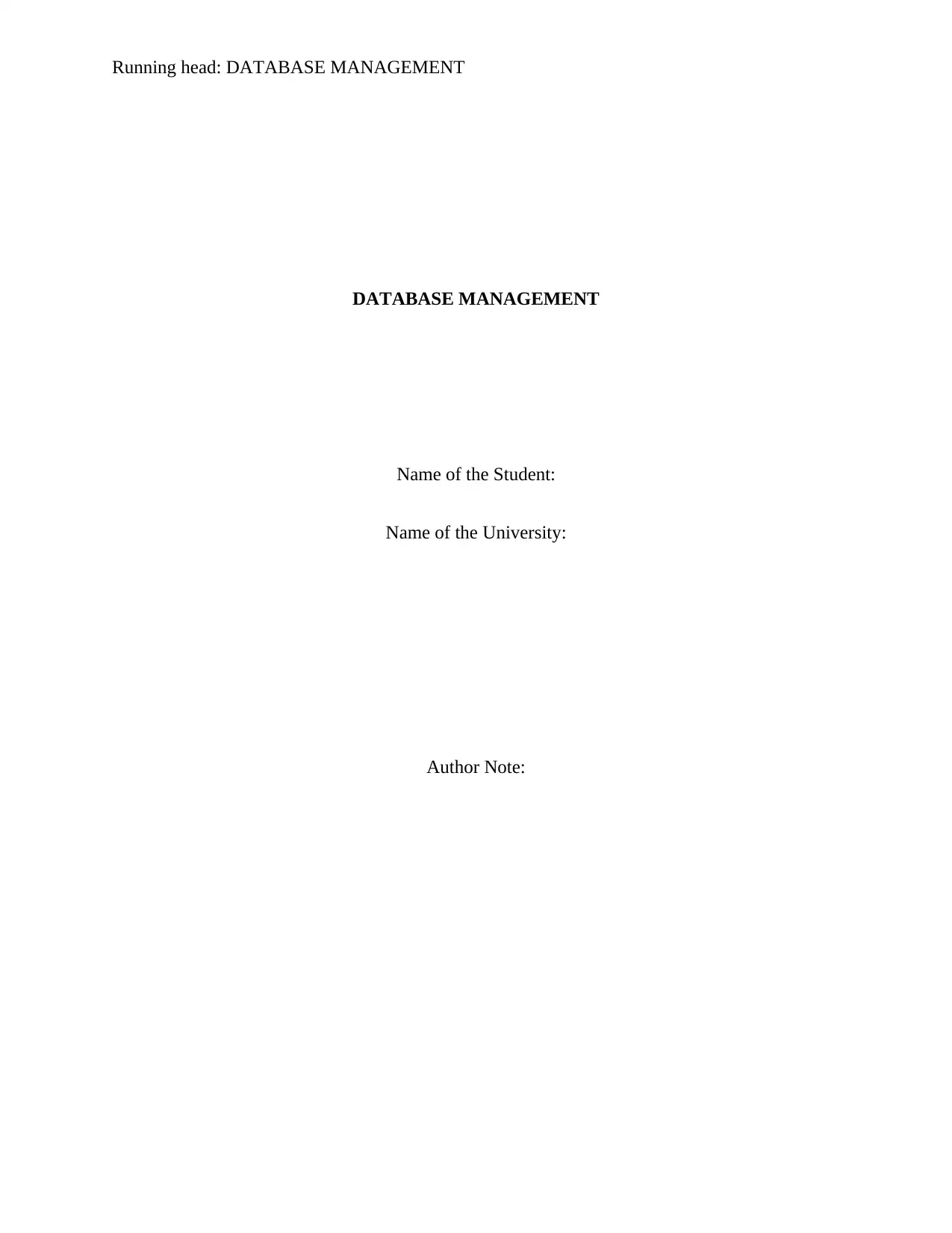
Running head: DATABASE MANAGEMENT
DATABASE MANAGEMENT
Name of the Student:
Name of the University:
Author Note:
DATABASE MANAGEMENT
Name of the Student:
Name of the University:
Author Note:
Paraphrase This Document
Need a fresh take? Get an instant paraphrase of this document with our AI Paraphraser
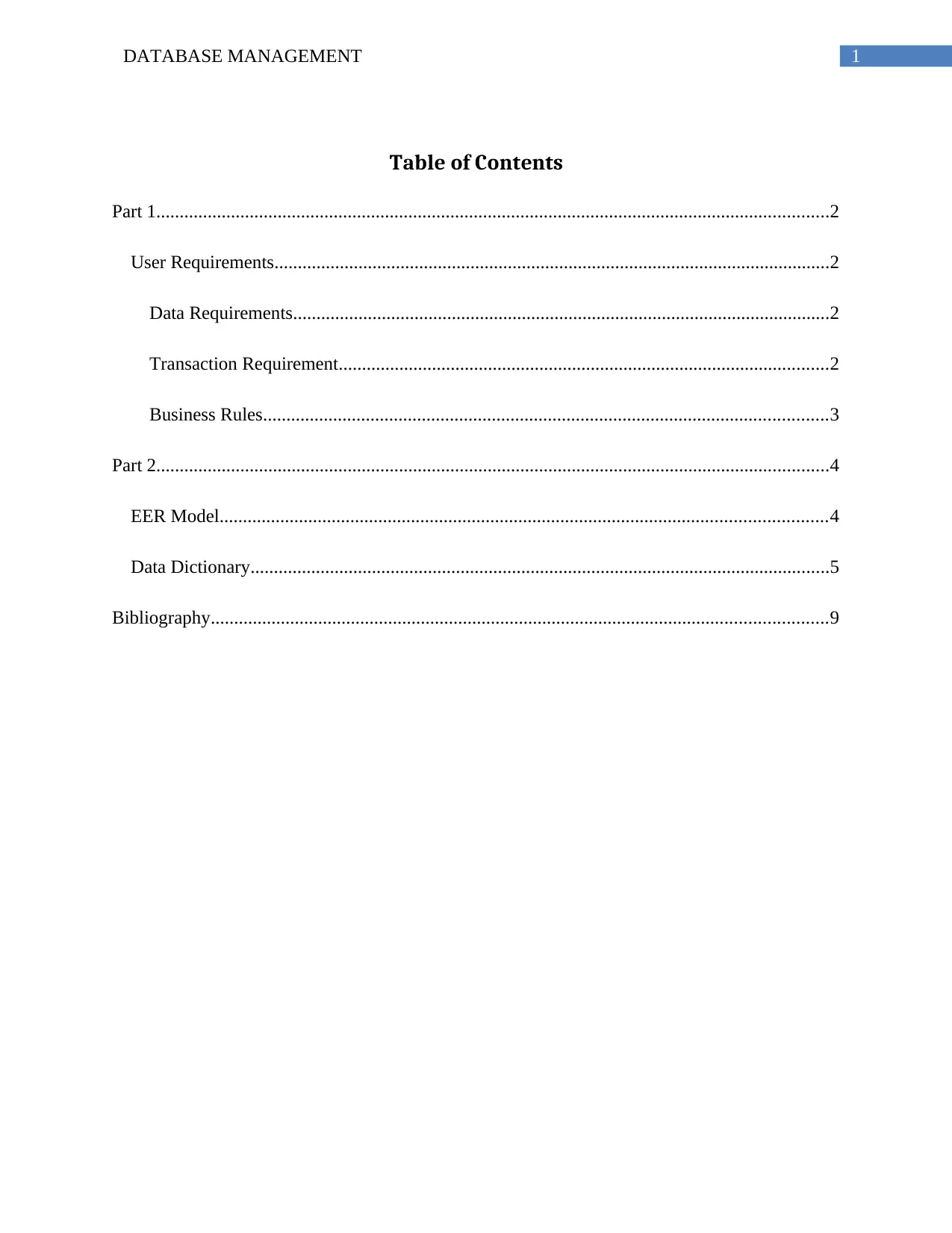
1DATABASE MANAGEMENT
Table of Contents
Part 1................................................................................................................................................2
User Requirements.......................................................................................................................2
Data Requirements...................................................................................................................2
Transaction Requirement.........................................................................................................2
Business Rules.........................................................................................................................3
Part 2................................................................................................................................................4
EER Model..................................................................................................................................4
Data Dictionary............................................................................................................................5
Bibliography....................................................................................................................................9
Table of Contents
Part 1................................................................................................................................................2
User Requirements.......................................................................................................................2
Data Requirements...................................................................................................................2
Transaction Requirement.........................................................................................................2
Business Rules.........................................................................................................................3
Part 2................................................................................................................................................4
EER Model..................................................................................................................................4
Data Dictionary............................................................................................................................5
Bibliography....................................................................................................................................9
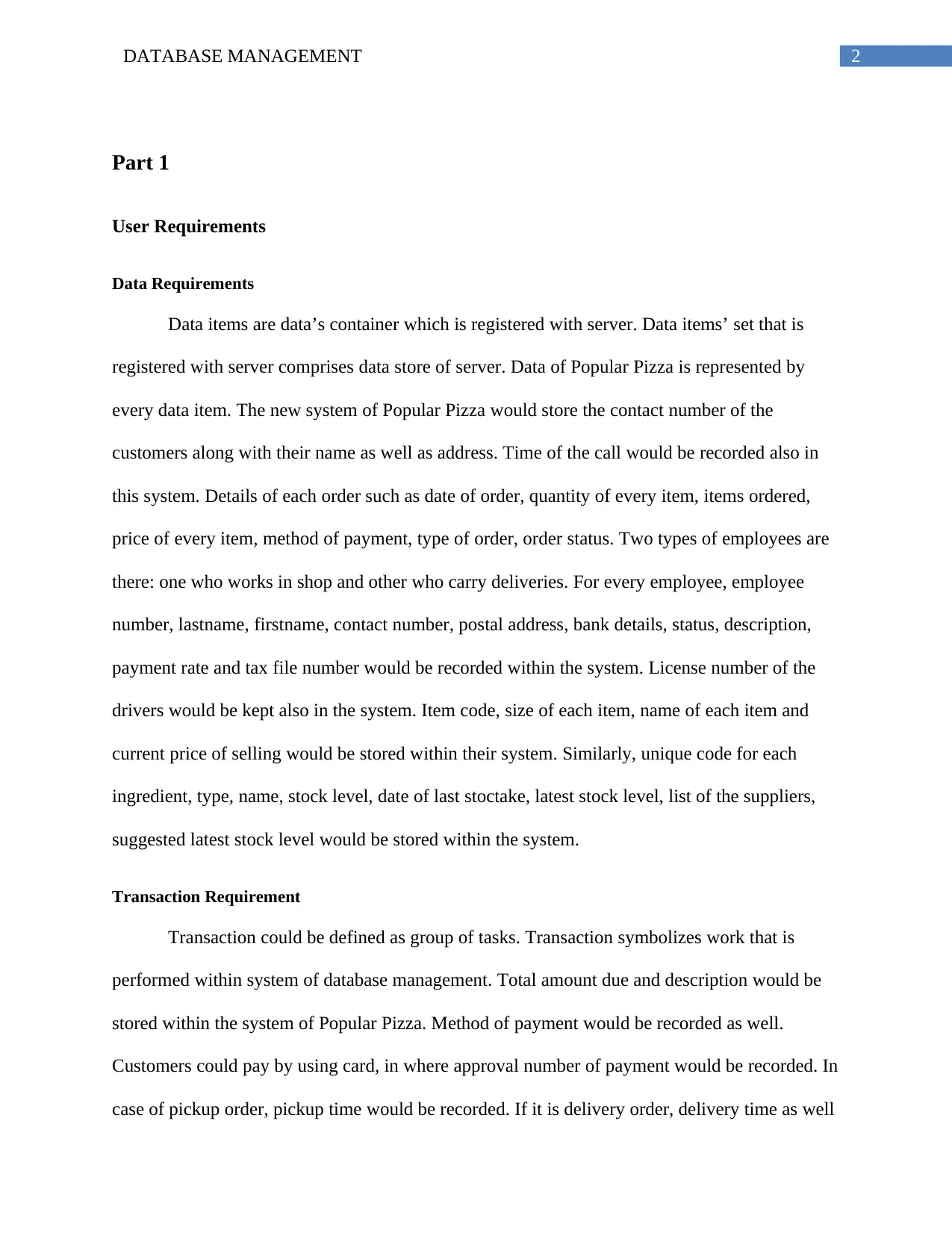
2DATABASE MANAGEMENT
Part 1
User Requirements
Data Requirements
Data items are data’s container which is registered with server. Data items’ set that is
registered with server comprises data store of server. Data of Popular Pizza is represented by
every data item. The new system of Popular Pizza would store the contact number of the
customers along with their name as well as address. Time of the call would be recorded also in
this system. Details of each order such as date of order, quantity of every item, items ordered,
price of every item, method of payment, type of order, order status. Two types of employees are
there: one who works in shop and other who carry deliveries. For every employee, employee
number, lastname, firstname, contact number, postal address, bank details, status, description,
payment rate and tax file number would be recorded within the system. License number of the
drivers would be kept also in the system. Item code, size of each item, name of each item and
current price of selling would be stored within their system. Similarly, unique code for each
ingredient, type, name, stock level, date of last stoctake, latest stock level, list of the suppliers,
suggested latest stock level would be stored within the system.
Transaction Requirement
Transaction could be defined as group of tasks. Transaction symbolizes work that is
performed within system of database management. Total amount due and description would be
stored within the system of Popular Pizza. Method of payment would be recorded as well.
Customers could pay by using card, in where approval number of payment would be recorded. In
case of pickup order, pickup time would be recorded. If it is delivery order, delivery time as well
Part 1
User Requirements
Data Requirements
Data items are data’s container which is registered with server. Data items’ set that is
registered with server comprises data store of server. Data of Popular Pizza is represented by
every data item. The new system of Popular Pizza would store the contact number of the
customers along with their name as well as address. Time of the call would be recorded also in
this system. Details of each order such as date of order, quantity of every item, items ordered,
price of every item, method of payment, type of order, order status. Two types of employees are
there: one who works in shop and other who carry deliveries. For every employee, employee
number, lastname, firstname, contact number, postal address, bank details, status, description,
payment rate and tax file number would be recorded within the system. License number of the
drivers would be kept also in the system. Item code, size of each item, name of each item and
current price of selling would be stored within their system. Similarly, unique code for each
ingredient, type, name, stock level, date of last stoctake, latest stock level, list of the suppliers,
suggested latest stock level would be stored within the system.
Transaction Requirement
Transaction could be defined as group of tasks. Transaction symbolizes work that is
performed within system of database management. Total amount due and description would be
stored within the system of Popular Pizza. Method of payment would be recorded as well.
Customers could pay by using card, in where approval number of payment would be recorded. In
case of pickup order, pickup time would be recorded. If it is delivery order, delivery time as well
⊘ This is a preview!⊘
Do you want full access?
Subscribe today to unlock all pages.

Trusted by 1+ million students worldwide
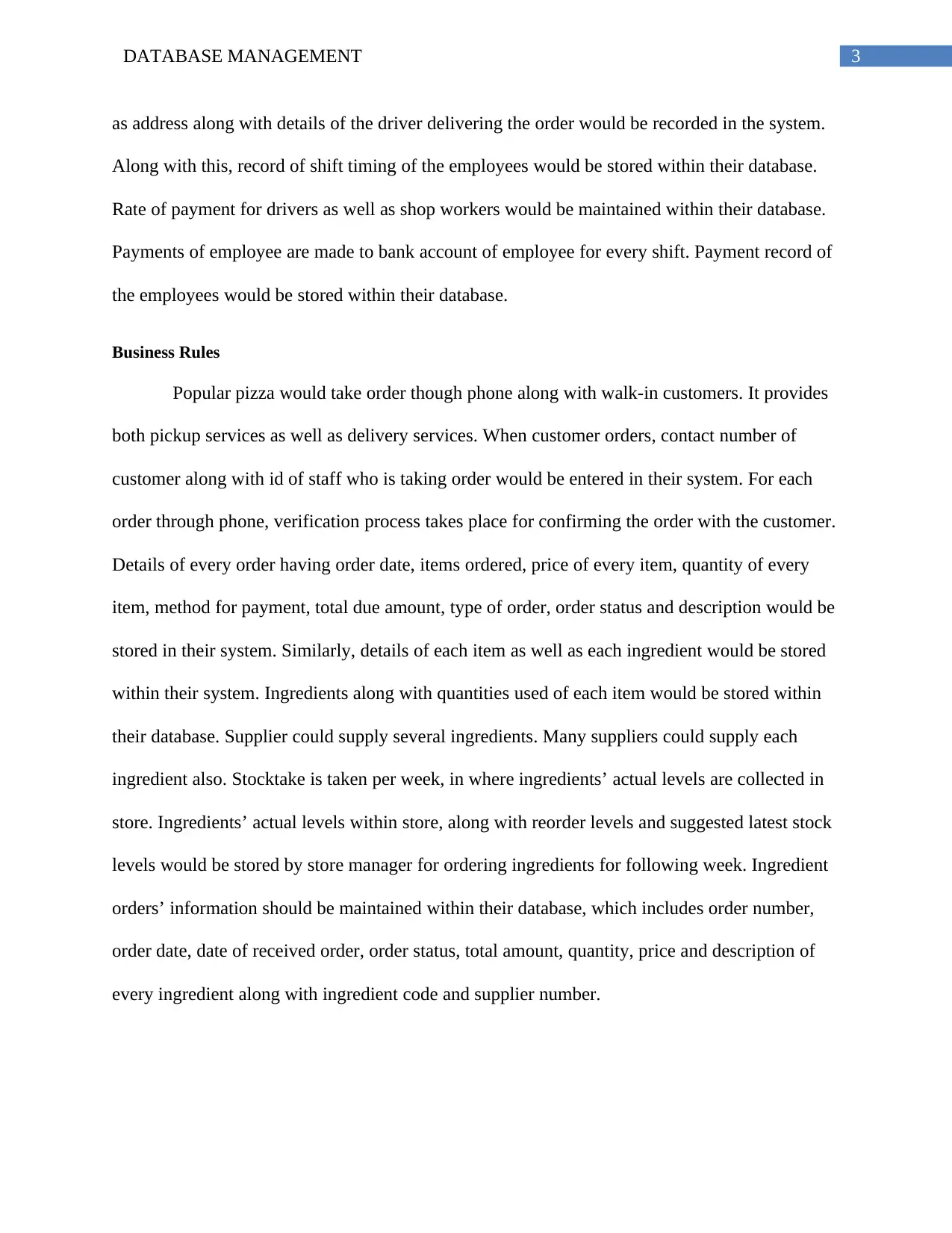
3DATABASE MANAGEMENT
as address along with details of the driver delivering the order would be recorded in the system.
Along with this, record of shift timing of the employees would be stored within their database.
Rate of payment for drivers as well as shop workers would be maintained within their database.
Payments of employee are made to bank account of employee for every shift. Payment record of
the employees would be stored within their database.
Business Rules
Popular pizza would take order though phone along with walk-in customers. It provides
both pickup services as well as delivery services. When customer orders, contact number of
customer along with id of staff who is taking order would be entered in their system. For each
order through phone, verification process takes place for confirming the order with the customer.
Details of every order having order date, items ordered, price of every item, quantity of every
item, method for payment, total due amount, type of order, order status and description would be
stored in their system. Similarly, details of each item as well as each ingredient would be stored
within their system. Ingredients along with quantities used of each item would be stored within
their database. Supplier could supply several ingredients. Many suppliers could supply each
ingredient also. Stocktake is taken per week, in where ingredients’ actual levels are collected in
store. Ingredients’ actual levels within store, along with reorder levels and suggested latest stock
levels would be stored by store manager for ordering ingredients for following week. Ingredient
orders’ information should be maintained within their database, which includes order number,
order date, date of received order, order status, total amount, quantity, price and description of
every ingredient along with ingredient code and supplier number.
as address along with details of the driver delivering the order would be recorded in the system.
Along with this, record of shift timing of the employees would be stored within their database.
Rate of payment for drivers as well as shop workers would be maintained within their database.
Payments of employee are made to bank account of employee for every shift. Payment record of
the employees would be stored within their database.
Business Rules
Popular pizza would take order though phone along with walk-in customers. It provides
both pickup services as well as delivery services. When customer orders, contact number of
customer along with id of staff who is taking order would be entered in their system. For each
order through phone, verification process takes place for confirming the order with the customer.
Details of every order having order date, items ordered, price of every item, quantity of every
item, method for payment, total due amount, type of order, order status and description would be
stored in their system. Similarly, details of each item as well as each ingredient would be stored
within their system. Ingredients along with quantities used of each item would be stored within
their database. Supplier could supply several ingredients. Many suppliers could supply each
ingredient also. Stocktake is taken per week, in where ingredients’ actual levels are collected in
store. Ingredients’ actual levels within store, along with reorder levels and suggested latest stock
levels would be stored by store manager for ordering ingredients for following week. Ingredient
orders’ information should be maintained within their database, which includes order number,
order date, date of received order, order status, total amount, quantity, price and description of
every ingredient along with ingredient code and supplier number.
Paraphrase This Document
Need a fresh take? Get an instant paraphrase of this document with our AI Paraphraser
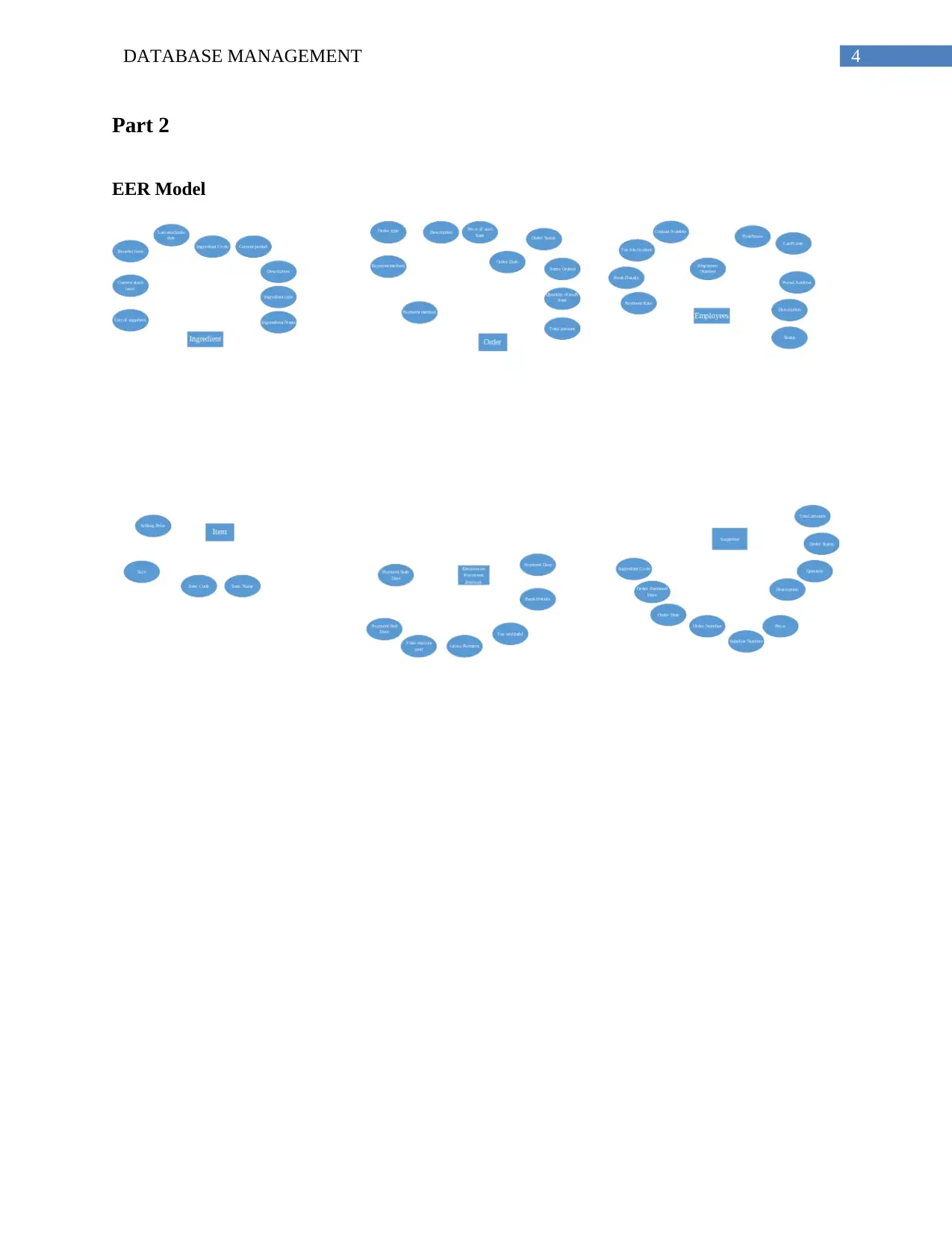
4DATABASE MANAGEMENT
Part 2
EER Model
Part 2
EER Model
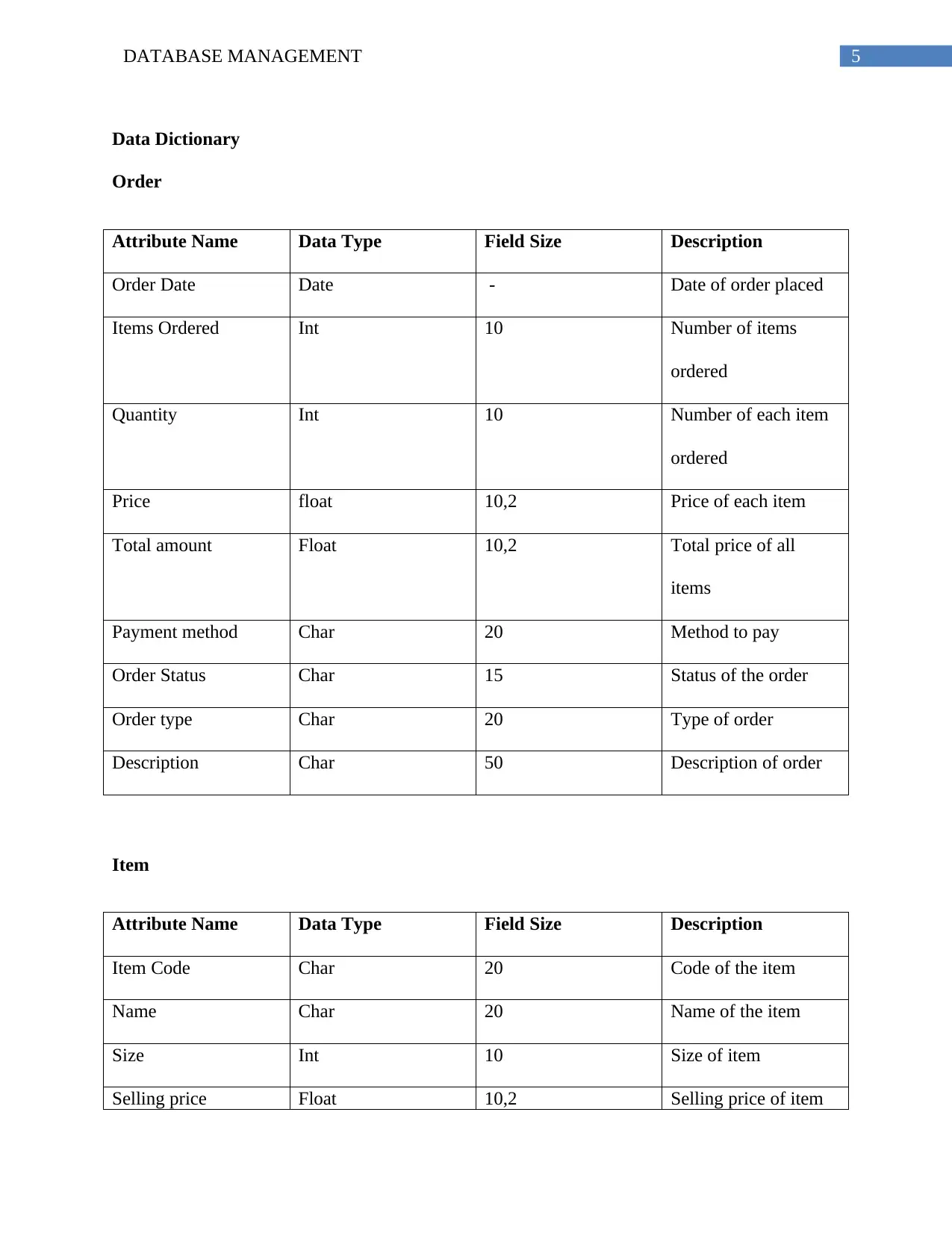
5DATABASE MANAGEMENT
Data Dictionary
Order
Attribute Name Data Type Field Size Description
Order Date Date - Date of order placed
Items Ordered Int 10 Number of items
ordered
Quantity Int 10 Number of each item
ordered
Price float 10,2 Price of each item
Total amount Float 10,2 Total price of all
items
Payment method Char 20 Method to pay
Order Status Char 15 Status of the order
Order type Char 20 Type of order
Description Char 50 Description of order
Item
Attribute Name Data Type Field Size Description
Item Code Char 20 Code of the item
Name Char 20 Name of the item
Size Int 10 Size of item
Selling price Float 10,2 Selling price of item
Data Dictionary
Order
Attribute Name Data Type Field Size Description
Order Date Date - Date of order placed
Items Ordered Int 10 Number of items
ordered
Quantity Int 10 Number of each item
ordered
Price float 10,2 Price of each item
Total amount Float 10,2 Total price of all
items
Payment method Char 20 Method to pay
Order Status Char 15 Status of the order
Order type Char 20 Type of order
Description Char 50 Description of order
Item
Attribute Name Data Type Field Size Description
Item Code Char 20 Code of the item
Name Char 20 Name of the item
Size Int 10 Size of item
Selling price Float 10,2 Selling price of item
⊘ This is a preview!⊘
Do you want full access?
Subscribe today to unlock all pages.

Trusted by 1+ million students worldwide
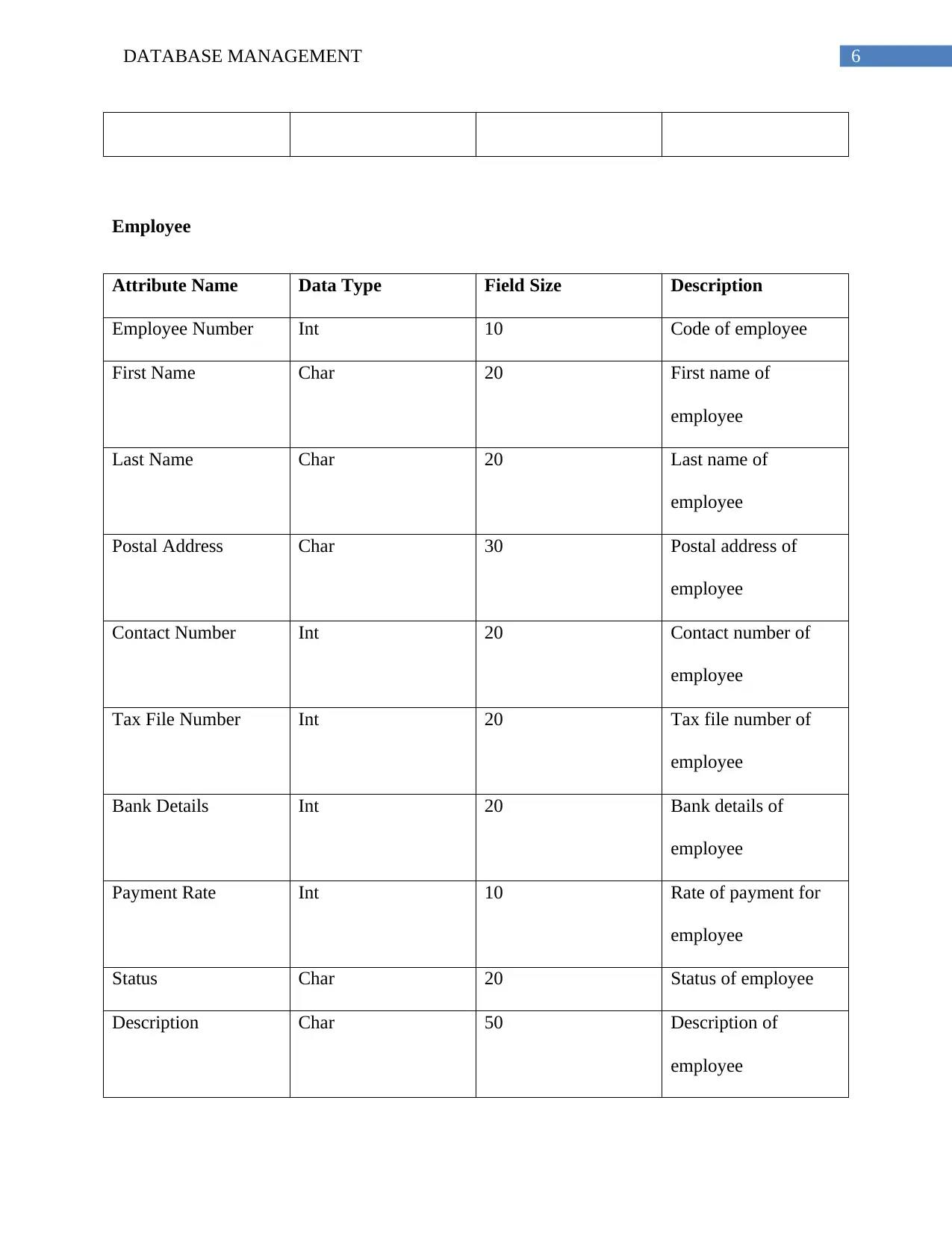
6DATABASE MANAGEMENT
Employee
Attribute Name Data Type Field Size Description
Employee Number Int 10 Code of employee
First Name Char 20 First name of
employee
Last Name Char 20 Last name of
employee
Postal Address Char 30 Postal address of
employee
Contact Number Int 20 Contact number of
employee
Tax File Number Int 20 Tax file number of
employee
Bank Details Int 20 Bank details of
employee
Payment Rate Int 10 Rate of payment for
employee
Status Char 20 Status of employee
Description Char 50 Description of
employee
Employee
Attribute Name Data Type Field Size Description
Employee Number Int 10 Code of employee
First Name Char 20 First name of
employee
Last Name Char 20 Last name of
employee
Postal Address Char 30 Postal address of
employee
Contact Number Int 20 Contact number of
employee
Tax File Number Int 20 Tax file number of
employee
Bank Details Int 20 Bank details of
employee
Payment Rate Int 10 Rate of payment for
employee
Status Char 20 Status of employee
Description Char 50 Description of
employee
Paraphrase This Document
Need a fresh take? Get an instant paraphrase of this document with our AI Paraphraser
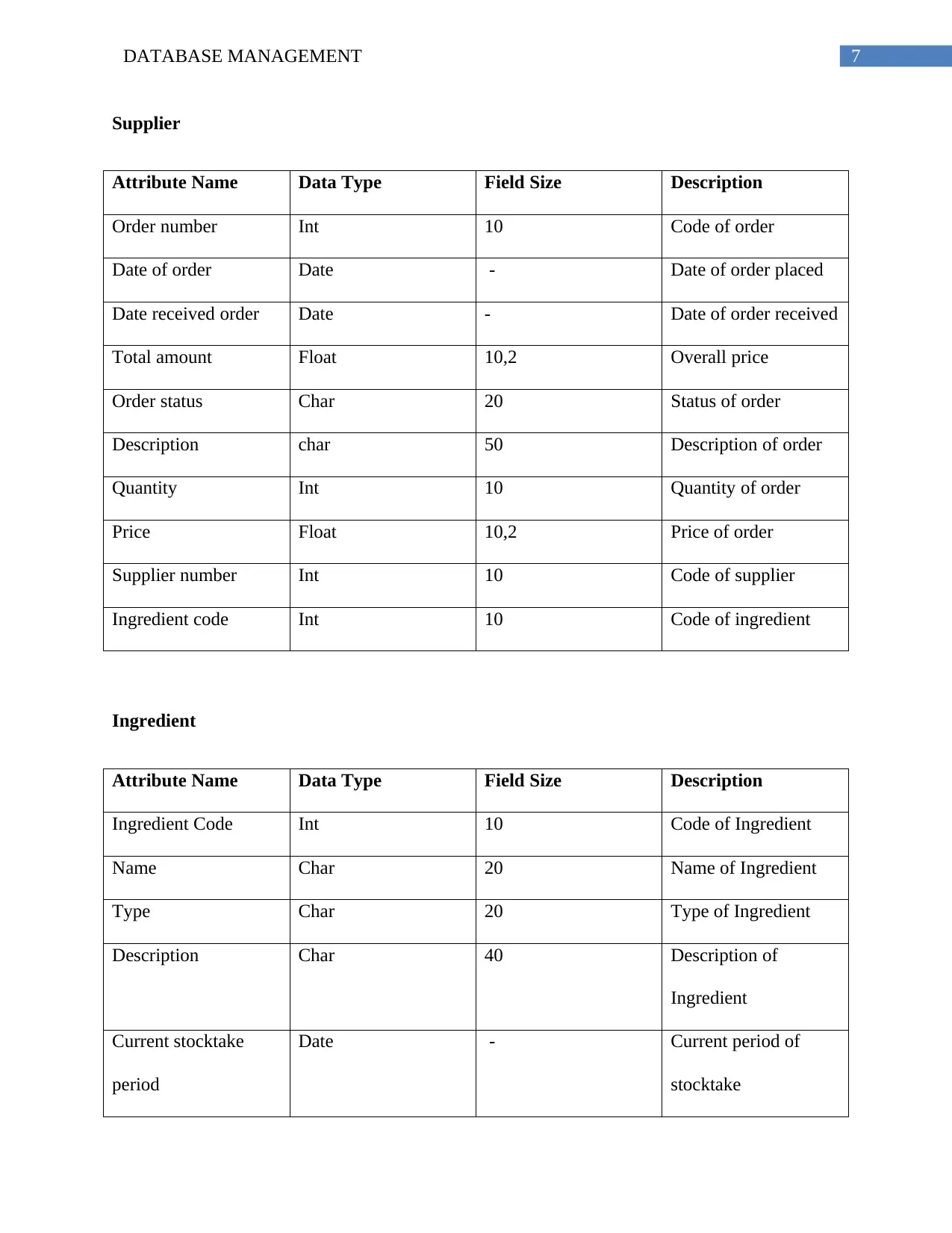
7DATABASE MANAGEMENT
Supplier
Attribute Name Data Type Field Size Description
Order number Int 10 Code of order
Date of order Date - Date of order placed
Date received order Date - Date of order received
Total amount Float 10,2 Overall price
Order status Char 20 Status of order
Description char 50 Description of order
Quantity Int 10 Quantity of order
Price Float 10,2 Price of order
Supplier number Int 10 Code of supplier
Ingredient code Int 10 Code of ingredient
Ingredient
Attribute Name Data Type Field Size Description
Ingredient Code Int 10 Code of Ingredient
Name Char 20 Name of Ingredient
Type Char 20 Type of Ingredient
Description Char 40 Description of
Ingredient
Current stocktake
period
Date - Current period of
stocktake
Supplier
Attribute Name Data Type Field Size Description
Order number Int 10 Code of order
Date of order Date - Date of order placed
Date received order Date - Date of order received
Total amount Float 10,2 Overall price
Order status Char 20 Status of order
Description char 50 Description of order
Quantity Int 10 Quantity of order
Price Float 10,2 Price of order
Supplier number Int 10 Code of supplier
Ingredient code Int 10 Code of ingredient
Ingredient
Attribute Name Data Type Field Size Description
Ingredient Code Int 10 Code of Ingredient
Name Char 20 Name of Ingredient
Type Char 20 Type of Ingredient
Description Char 40 Description of
Ingredient
Current stocktake
period
Date - Current period of
stocktake
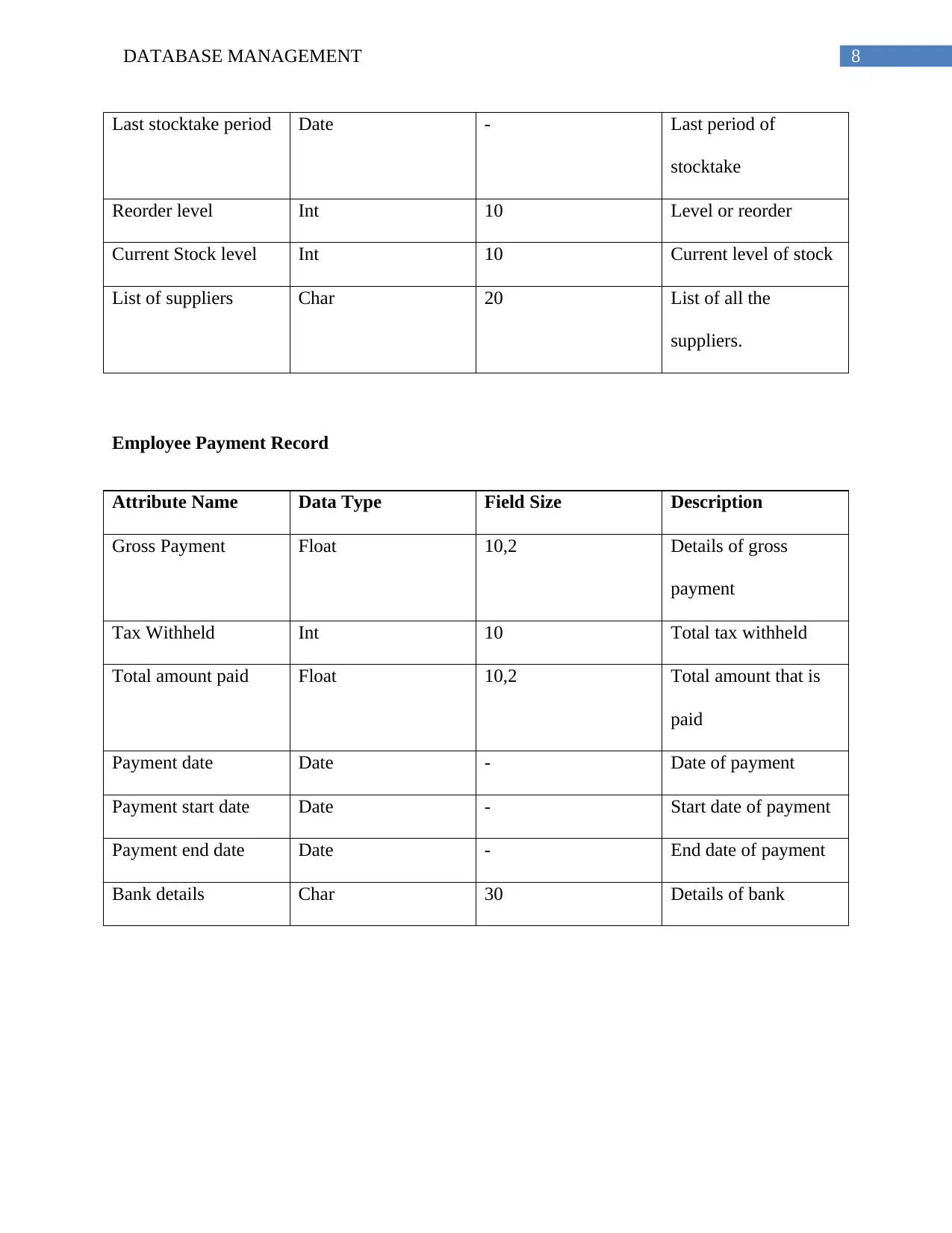
8DATABASE MANAGEMENT
Last stocktake period Date - Last period of
stocktake
Reorder level Int 10 Level or reorder
Current Stock level Int 10 Current level of stock
List of suppliers Char 20 List of all the
suppliers.
Employee Payment Record
Attribute Name Data Type Field Size Description
Gross Payment Float 10,2 Details of gross
payment
Tax Withheld Int 10 Total tax withheld
Total amount paid Float 10,2 Total amount that is
paid
Payment date Date - Date of payment
Payment start date Date - Start date of payment
Payment end date Date - End date of payment
Bank details Char 30 Details of bank
Last stocktake period Date - Last period of
stocktake
Reorder level Int 10 Level or reorder
Current Stock level Int 10 Current level of stock
List of suppliers Char 20 List of all the
suppliers.
Employee Payment Record
Attribute Name Data Type Field Size Description
Gross Payment Float 10,2 Details of gross
payment
Tax Withheld Int 10 Total tax withheld
Total amount paid Float 10,2 Total amount that is
paid
Payment date Date - Date of payment
Payment start date Date - Start date of payment
Payment end date Date - End date of payment
Bank details Char 30 Details of bank
⊘ This is a preview!⊘
Do you want full access?
Subscribe today to unlock all pages.

Trusted by 1+ million students worldwide
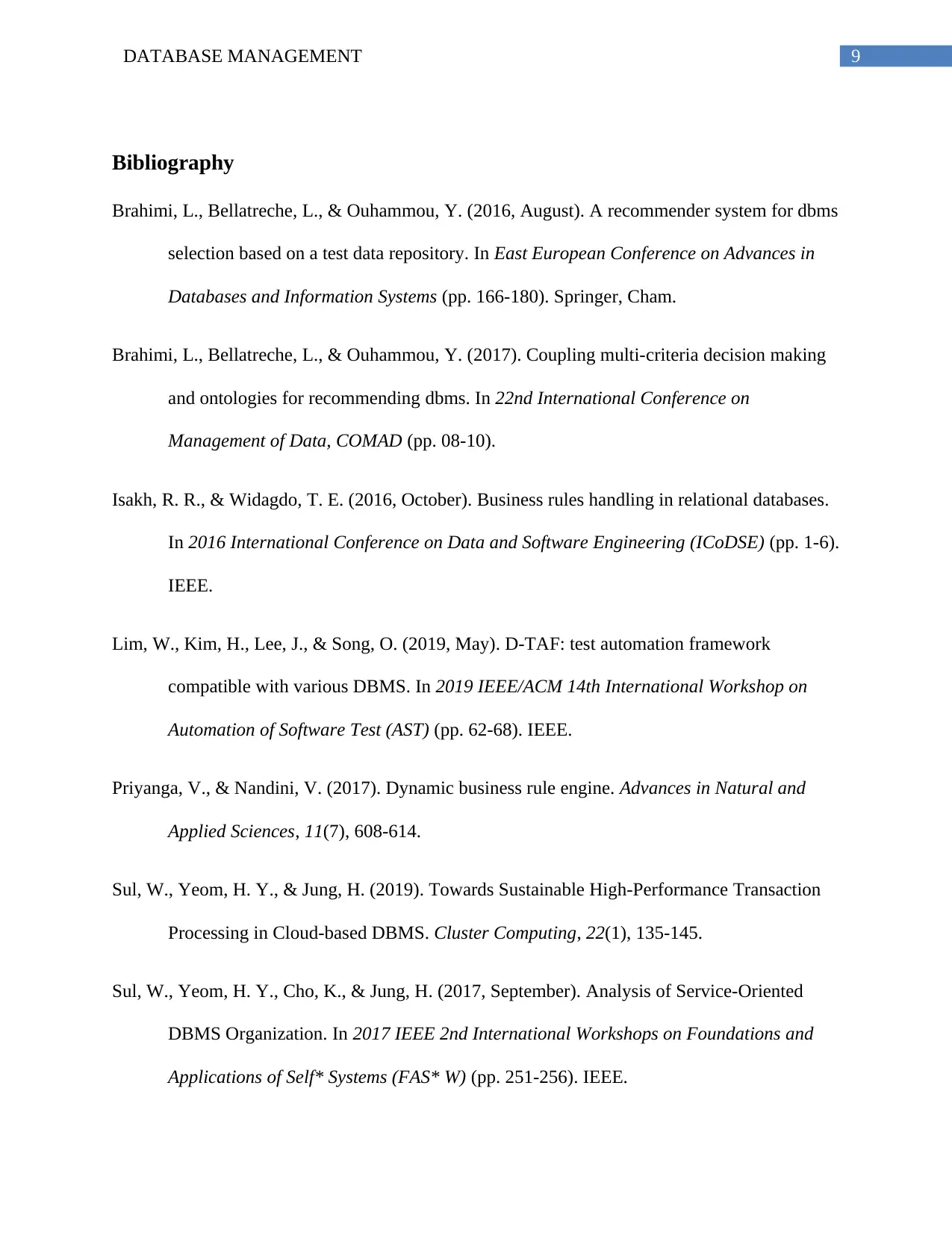
9DATABASE MANAGEMENT
Bibliography
Brahimi, L., Bellatreche, L., & Ouhammou, Y. (2016, August). A recommender system for dbms
selection based on a test data repository. In East European Conference on Advances in
Databases and Information Systems (pp. 166-180). Springer, Cham.
Brahimi, L., Bellatreche, L., & Ouhammou, Y. (2017). Coupling multi-criteria decision making
and ontologies for recommending dbms. In 22nd International Conference on
Management of Data, COMAD (pp. 08-10).
Isakh, R. R., & Widagdo, T. E. (2016, October). Business rules handling in relational databases.
In 2016 International Conference on Data and Software Engineering (ICoDSE) (pp. 1-6).
IEEE.
Lim, W., Kim, H., Lee, J., & Song, O. (2019, May). D-TAF: test automation framework
compatible with various DBMS. In 2019 IEEE/ACM 14th International Workshop on
Automation of Software Test (AST) (pp. 62-68). IEEE.
Priyanga, V., & Nandini, V. (2017). Dynamic business rule engine. Advances in Natural and
Applied Sciences, 11(7), 608-614.
Sul, W., Yeom, H. Y., & Jung, H. (2019). Towards Sustainable High-Performance Transaction
Processing in Cloud-based DBMS. Cluster Computing, 22(1), 135-145.
Sul, W., Yeom, H. Y., Cho, K., & Jung, H. (2017, September). Analysis of Service-Oriented
DBMS Organization. In 2017 IEEE 2nd International Workshops on Foundations and
Applications of Self* Systems (FAS* W) (pp. 251-256). IEEE.
Bibliography
Brahimi, L., Bellatreche, L., & Ouhammou, Y. (2016, August). A recommender system for dbms
selection based on a test data repository. In East European Conference on Advances in
Databases and Information Systems (pp. 166-180). Springer, Cham.
Brahimi, L., Bellatreche, L., & Ouhammou, Y. (2017). Coupling multi-criteria decision making
and ontologies for recommending dbms. In 22nd International Conference on
Management of Data, COMAD (pp. 08-10).
Isakh, R. R., & Widagdo, T. E. (2016, October). Business rules handling in relational databases.
In 2016 International Conference on Data and Software Engineering (ICoDSE) (pp. 1-6).
IEEE.
Lim, W., Kim, H., Lee, J., & Song, O. (2019, May). D-TAF: test automation framework
compatible with various DBMS. In 2019 IEEE/ACM 14th International Workshop on
Automation of Software Test (AST) (pp. 62-68). IEEE.
Priyanga, V., & Nandini, V. (2017). Dynamic business rule engine. Advances in Natural and
Applied Sciences, 11(7), 608-614.
Sul, W., Yeom, H. Y., & Jung, H. (2019). Towards Sustainable High-Performance Transaction
Processing in Cloud-based DBMS. Cluster Computing, 22(1), 135-145.
Sul, W., Yeom, H. Y., Cho, K., & Jung, H. (2017, September). Analysis of Service-Oriented
DBMS Organization. In 2017 IEEE 2nd International Workshops on Foundations and
Applications of Self* Systems (FAS* W) (pp. 251-256). IEEE.
Paraphrase This Document
Need a fresh take? Get an instant paraphrase of this document with our AI Paraphraser

10DATABASE MANAGEMENT
Suseela, V. J., & Uma, V. (2017). Data Management for Libraries: Understanding DBMS,
RDBMS, IR Technologies & Tools. Ess Ess Publications.
Suseela, V. J., & Uma, V. (2017). Data Management for Libraries: Understanding DBMS,
RDBMS, IR Technologies & Tools. Ess Ess Publications.
1 out of 11
Related Documents
Your All-in-One AI-Powered Toolkit for Academic Success.
+13062052269
info@desklib.com
Available 24*7 on WhatsApp / Email
![[object Object]](/_next/static/media/star-bottom.7253800d.svg)
Unlock your academic potential
Copyright © 2020–2025 A2Z Services. All Rights Reserved. Developed and managed by ZUCOL.





